This guide contains new healthcare planning strategies, their benefits, examples, traps to avoid, and all you need to know.
Whether you’re a medical business owner, an executive, or a practitioner, my promise to you is that, by the end of this article, you’ll get a razor-sharp understanding of what strategic planning is and how it can skyrocket your operational efficiency.
Here’s a brief outline of what I’ll cover:
- What is strategic planning in healthcare?
- The importance of strategic planning in healthcare
- 3 Common Mistakes when implementing strategies
- The best 8 healthcare planning strategies
- ‘Secret’ to a fruitful healthcare planning campaigns
What is strategic planning in healthcare?
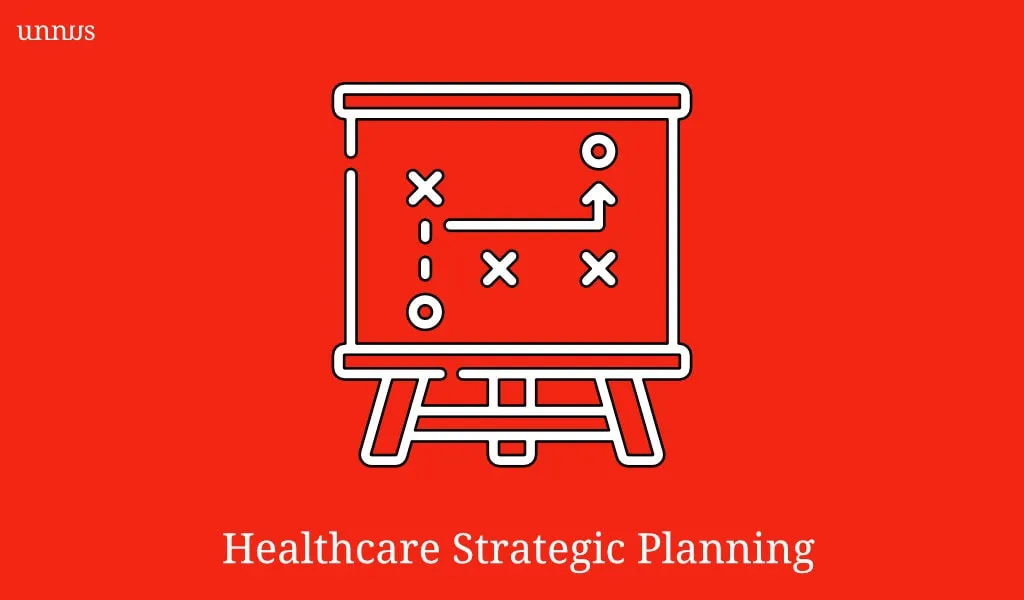
Strategic planning in healthcare is setting long-term objectives for your medical business and an action plan to hit your target goals. It’s about taking a proactive approach to building a future-proof medical brand.
There are many strategies (which we’re going to look at) to achieve a strategy-driven business model, but before we go deep into the details, let’s check how this can benefit your practice.
The benefit of strategic planning in healthcare
With a good strategic approach comes great advantages for your medical business.
1) It protect your medical business from unforeseen risks

With the Covid-19 situation, healthcare providers no longer can afford to function reactively. And this is where SP (strategic planning) comes into place. SP, by nature, is a proactive approach. It is focused on long-term goals and future-oriented planning.
This not only immune you against any unlooked-for risks but arms you with a well-crafted plan of what should be done in the face of uncertainty.
The Planning Strategy should work as the shatterproof window for your practice.
2) It speeds up your medical business growth
Having a strategy in place holds everyone involved accountable. This means an increased commitment from your team and faster work processes.
Furthermore, according to Parkinson’s Law, any team, when giving a task, will fill whatever time was allocated for its completion. This not only quickens your operational efficiency, but it also skyrockets your work productivity and patient outcomes.
This enhanced workflow will accelerate the rate at which your medical business grows. Resulting in a faster profit cycle.
The next graph illustrates how business growth rate correlates with operational efficiency.
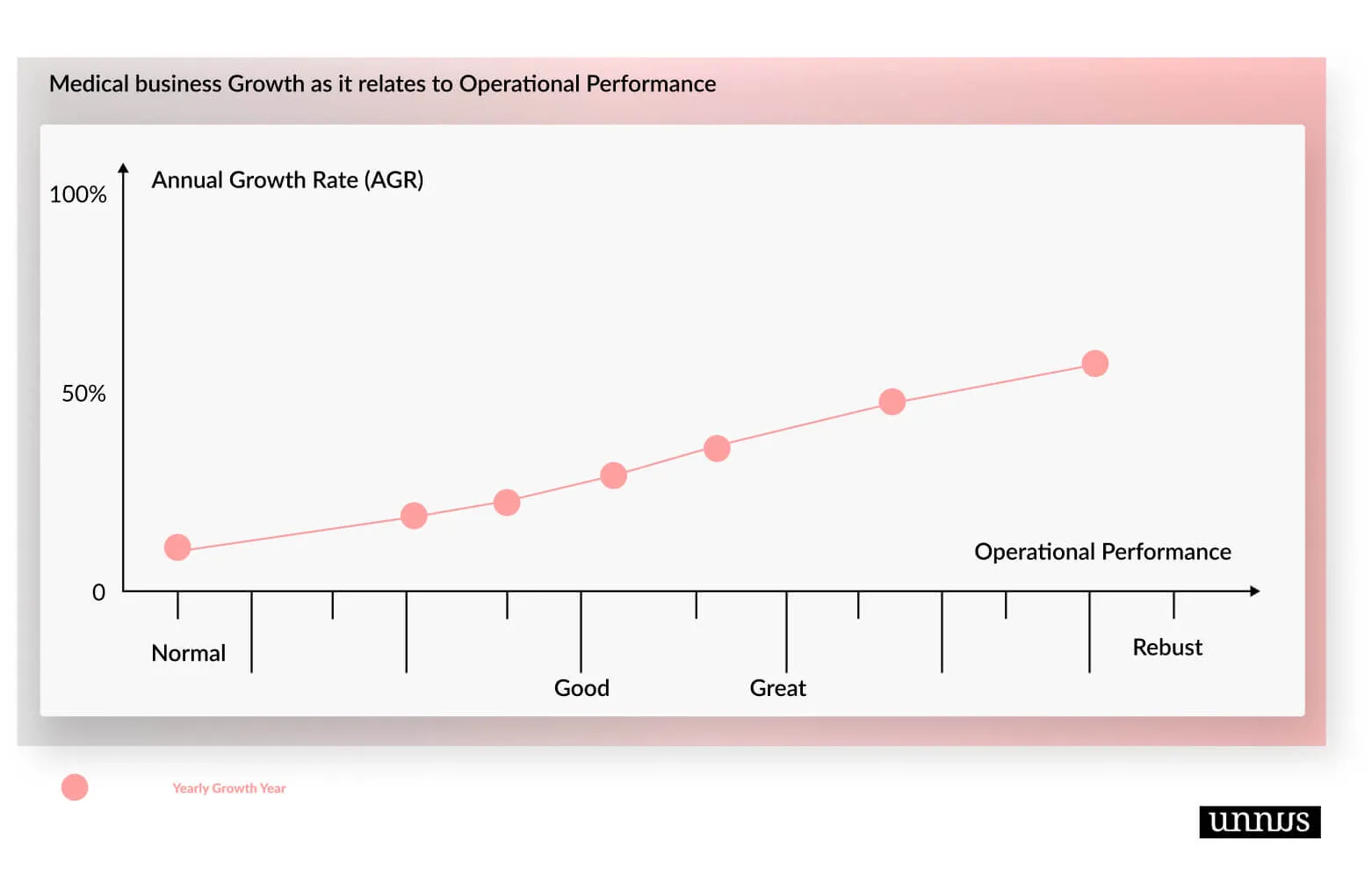
3) It creates a cohesive workplace for your medical business

Medical businesses routinely separate functions to hierarchical levels to achieve efficiencies, However…
These divides lead to confusion, anxiety, and distrust as employees work at cross-purposes, taking refuge in functional silos instead of a collaborative ecosystem.
This makes your medical staff sub-optimizing when you need all parts working together.
Employees go about directionless, without an understanding of their role in delivering the (non-existent) consistent experience for patients.
To combat this, putting a strategic vision for your business ensures cohesiveness and a united workforce.
The bottom line is: the result of having a shared strategic vision is coherence; the result of aimless workflow is wasted resources.
4) It increases your profit margin

Great medical business owners aim for the stars and land on the moon. And this is what makes strategic financial planning great. It forces you to aim high. This kind of planning breaks the chains of the self-limiting beliefs that are preventing you and your staff from achieving a higher rate of profit margins.
Not only that, but it also makes sure that what you’re doing is directed by a strategy and measurable KPIs (key performance indicators) and not by a mere accumulation of tactics that don’t add up together.
This results in a well-tracked process, efficient way of working, and increased profitability.
3 Common mistakes when implementing healthcare strategic planning
Let’s explore common mistakes medical business fall into when implementing strategic planning workshops.
1) Disregarding their branding efforts
Any medical practice can have strategies, but great medical businesses let their brand act as a decisional filter for their planning effort.
Does your strategy align perfectly with your brand’s core attribute? Does this plan solidify your place in the market or does it weaken your brand’s perceived value? If you don’t have a grounded brand in place, your strategy might end up hurting your medical business.
If you’d like to learn more about brand building and how can you build a mouth-watering brand, you can check our free healthcare branding guide .

2) Focusing on too many metrics and KPIs
Getting distracted by too many metrics is the fast lane to a crumbling healthcare plan. Many practices try to implement a strategy but end up focusing on the wrong metrics and getting overwhelmed.
It is best to list out critical KPIs (key performance indicators) for your medical brand before embarking on a strategy.
3) Lack of professional facilitators
Any healthcare strategic plan needs a good facilitator. A facilitator that has a great knowledge of the healthcare industry know-how and its business side of things. Common trap healthcare organizations or practices fall into is trying to implement these strategies in-house. This leads to unproductive workshops and unfruitful results.
We strongly advise you to outsource these strategies to great facilitators that have past-experience running healthcare strategic planning workshops. This will save you time and provide you with the best result for your medical business.
Best Healthcare Planning Strategies (With Examples)
Let’s go through some of the essentials of strategic planning methods in healthcare.
1) S.W.O.T Analysis Strategy
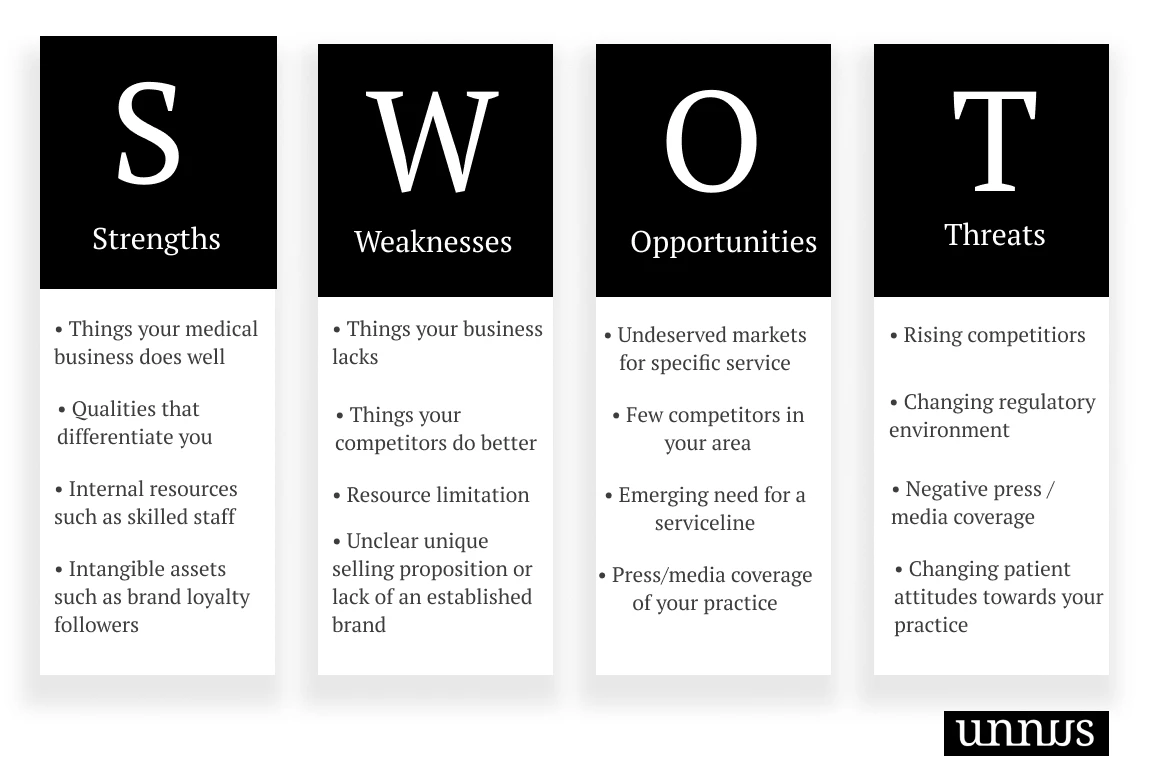
S.W.O.T is a strategic planning technique used to define your healthcare organization’s (or practice’s) Strengths, Weaknesses, Opportunities, and Threats in the competitive landscape.
SWOT Analysis arms you with a clear overview of critical metrics that are key for your performance and the overall success of your medical business.
Let’s see some examples of SWOT Diagrams in healthcare.
Hospital strategic plan: SWOT example
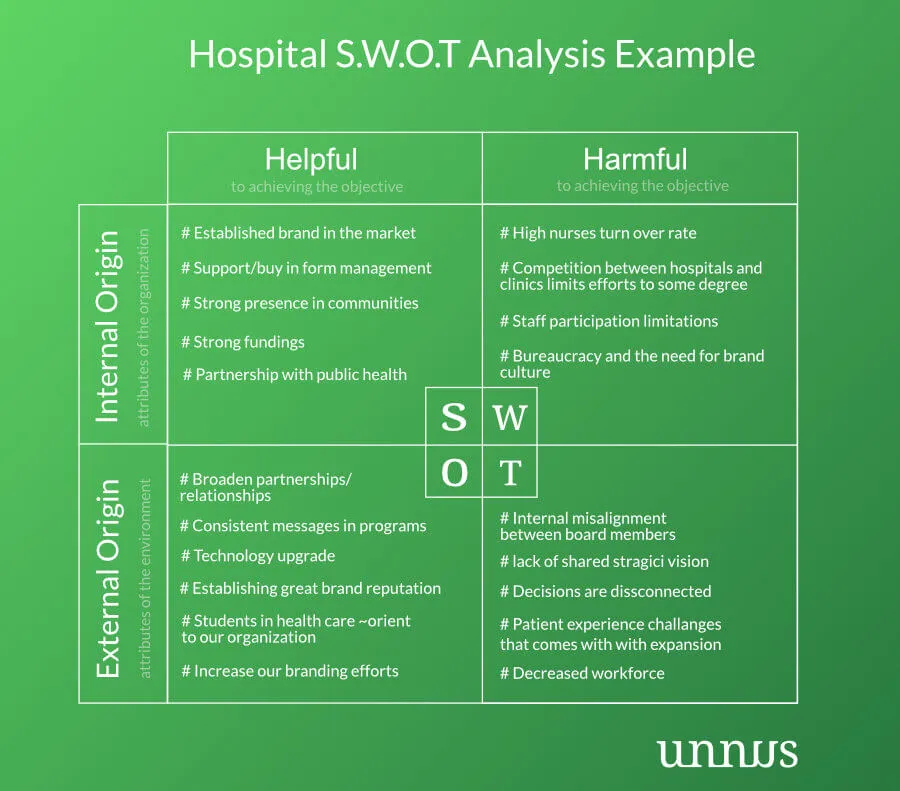
Strategic planning in nursing: SWOT Example
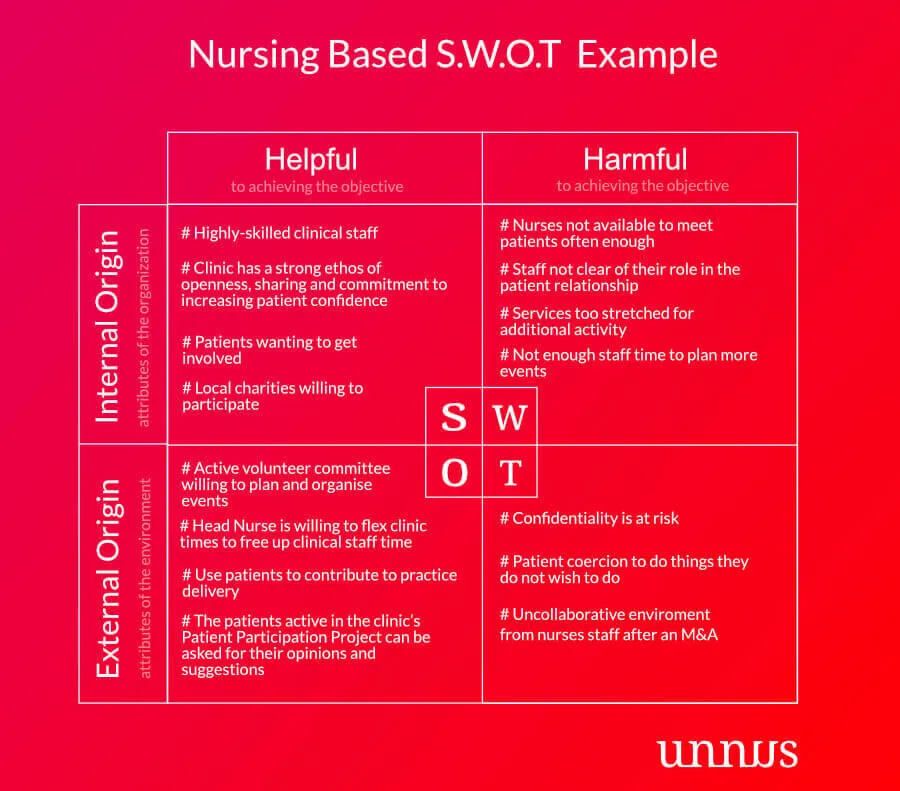
2) S.W.O.T Strategy Canvas™
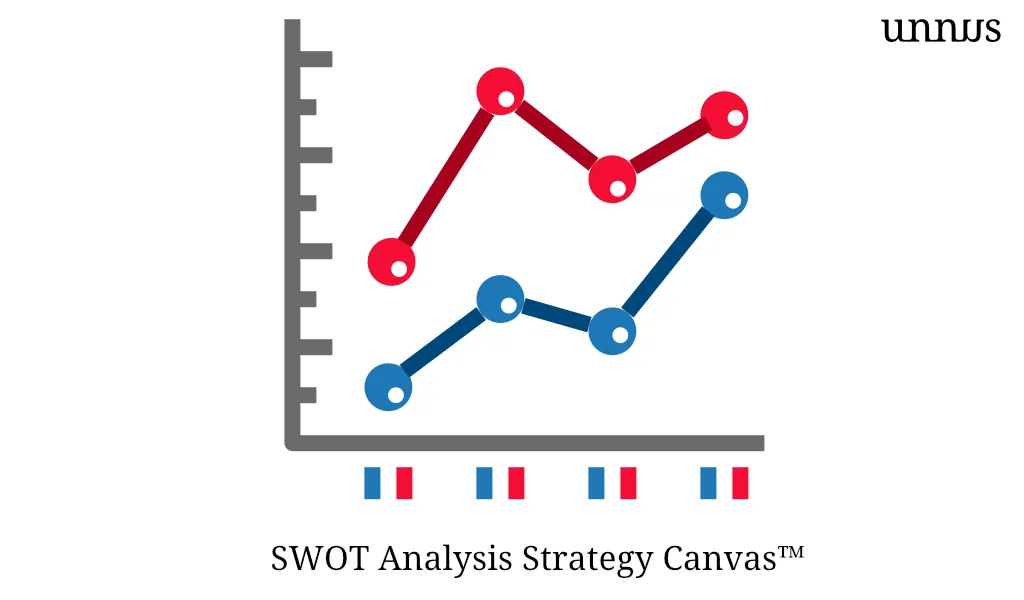
SWOT Analysis is not enough to measure the success of your efforts.
That’s why our team at unnus developed the SWOT Strategy Canvas™ (SSC), a visual representation graph of the impact SWOT has on your medical brand.
The SSC could be conducted every 6 months to track the efficiency and the effort of SWOT.
SSC graph tracks the Impact Rate of each element of the SWOT (strengths, weaknesses, opportunities, and threats). The goal is to witness a low Impact Rate of weakness and threats and a high Impact Rate of Strengths and Opportunities.
If you’d like to know more about the how-tos and other details of SWOT analysis and SSC, check our step-by-step guide on SWOT here .
3) Brand Vision Strategy

Brand Vision Strategy is a planning method used to define concrete objectives for your medical brand and set up trackable metrics for the overarching vision.
The Brand Vision Strategy has three stages:
- 15 Year Vision Timeline
- Brand Obituary
- Vision Strategy Matrix
Let’s see how the three stages overlap.
#First~ The 15 Year Vision Plan
The 15 Year vision Plan is where we start defining the higher goals and aspirations that your medical business needs to achieve.
The benefit of this stage are threefold:
- It ensures that you know where your medical business is headed
- It works as a pathway to check back against when measuring your progress
- Forces you and your team to aim high and set a bold goals
#Second~ Brand Obituary
What will happen if your practice closes its door tomorrow? Would journalists write headlines heralding your past achievements, or would their stories simply add you to a list of bygones? Would employees wonder how it could have ended, or would they have known it was inevitable? Would patients mourn your passing, or would the demise of your medical brand go unnoticed?
Unlike the 15 Year Vision Plan, this method works as a risk assessment and proactive approach for future commitment.
This exercise will force you to think through some of the key elements that make up your brand.
Here’s an example of this technique from our client, a dental practice Confidental™.
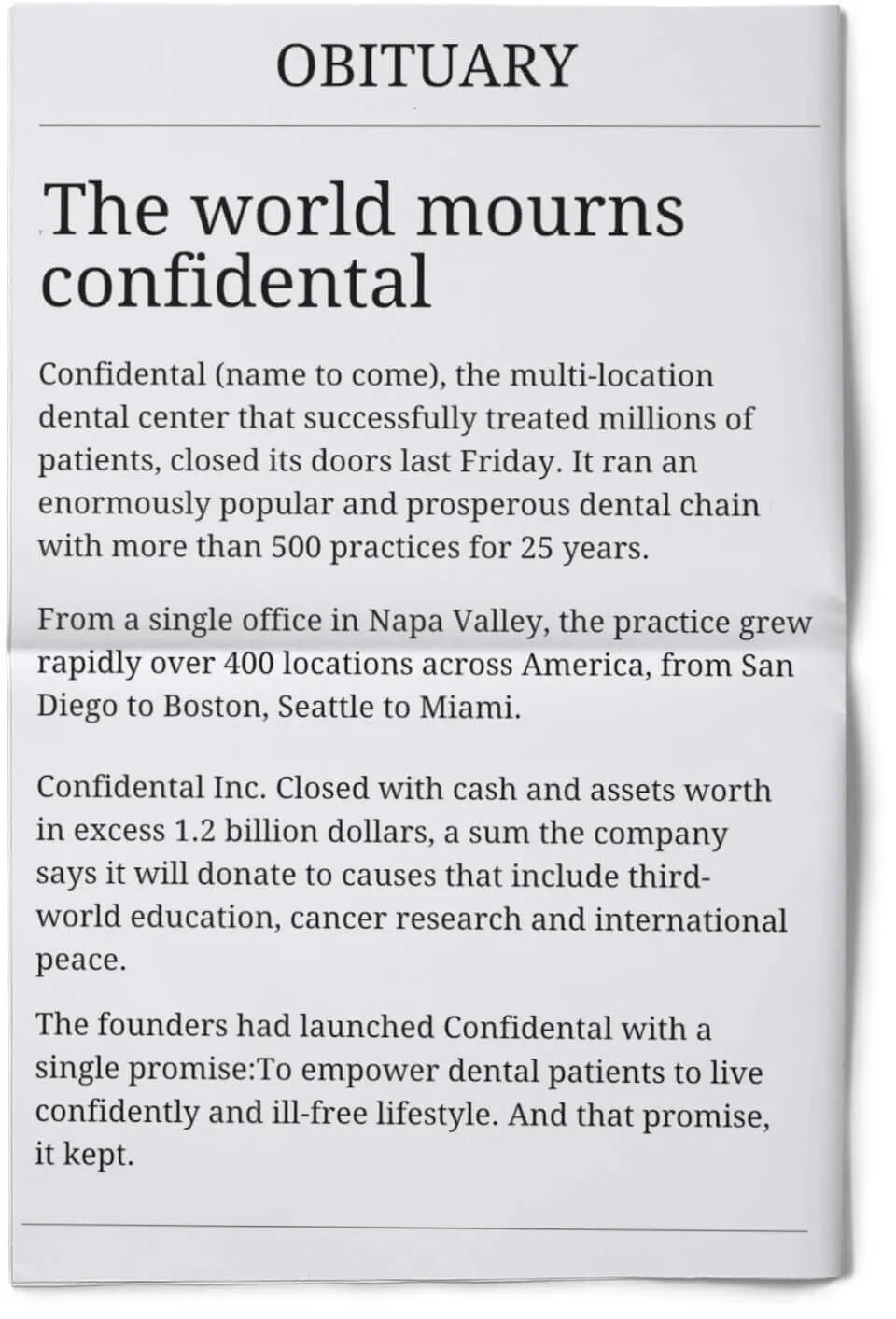
#Third~ Brand Vision Matrix
In this stage, we get strategic by defining a set of metrics to track and check back against your overarching vision. This stage focuses on tracking and measuring your progress towards the final goal of the strategy.
The metrics that we’re going to measure in this stage fall into four categories:
- Internal Business Process
- Some of the most important measures of internal business performance are overall productivity rates, ability to meet deadlines on time, and ability to achieve previously set goals and this category will contain all necessary metrics for that.
- Learning And Growth
- Tracking how your medical staff is growing will help facilitate the overall team goals. You’ll want to keep track of employee morale, how knowledgeable staff is, and how reliably they use the business’s best practices.
- Stakeholders
- It is critical to capture the efficiency of your stakeholders to gauge the overall performance of your medical business. This section is focused on staff, team, and shareholders.
- Financial performance
- Most medical businesses find it useful to measure the business’s progress toward financial goals. Common measures of financial performance include revenues, return on investment, earnings, cost per case, etc.
Each category will contain the following:
- Set of objectives that are relevant to it
- Measurement and matrices
- Progress Record of each target
- Initiatives (what are we doing hit that target)
Here’s an example of a hospital’s Brand Vision Matrix:
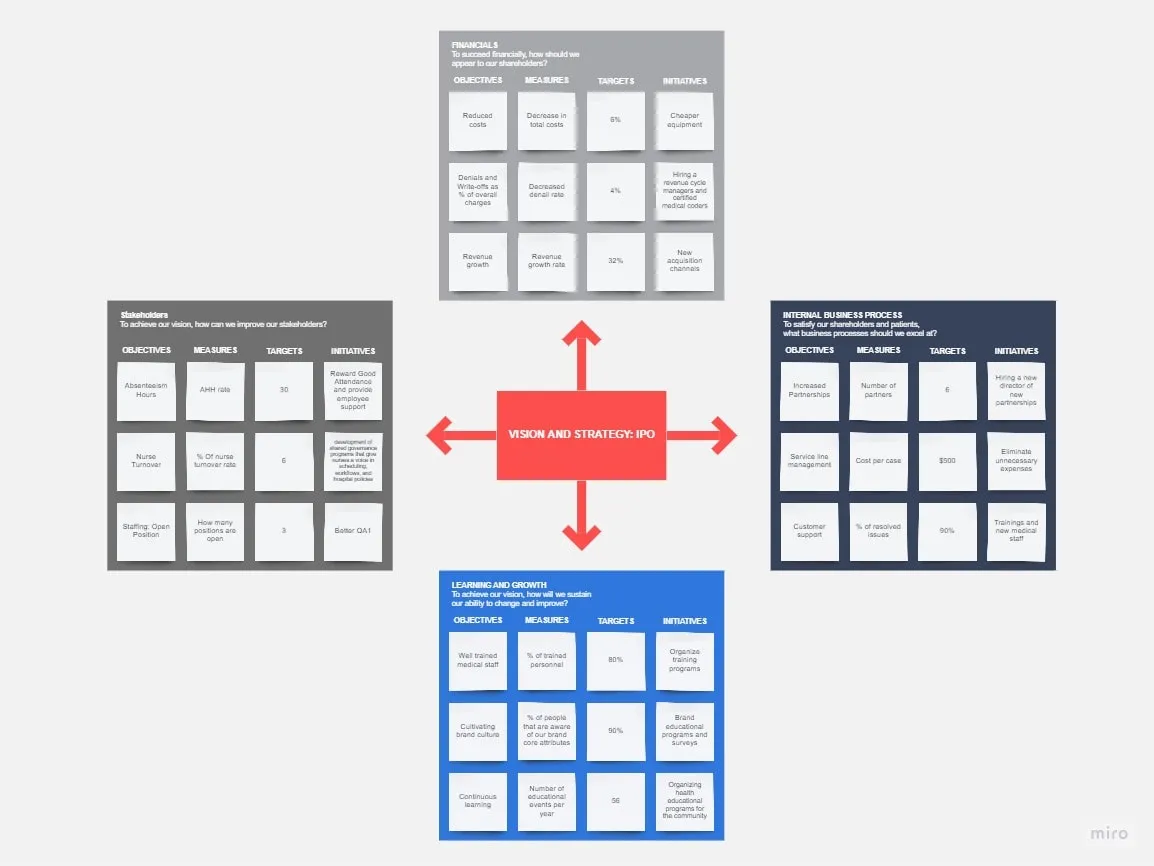
4) Brand Cause And Effect Strategy

This strategy helps you pinpoint the root causes of complex problems that are hindering your business growth. The premise of this strategy is to take on a big problem and start dissecting it into categorical components or “sub issues”.
This way you can spot deeply-embedded issues that are causing the main problem. You can think of this strategy as more a way to treat the problem rather than finding it.
The benefits of this strategy are:
- Better visualization of your medical business risks
- Treating the causes rather than the symptoms of the problem
- Gets you out of the tunnel vision trap and provide you with a clear picture of the challenges your business might face
Here’s an example for this strategic planning technique for a hospital
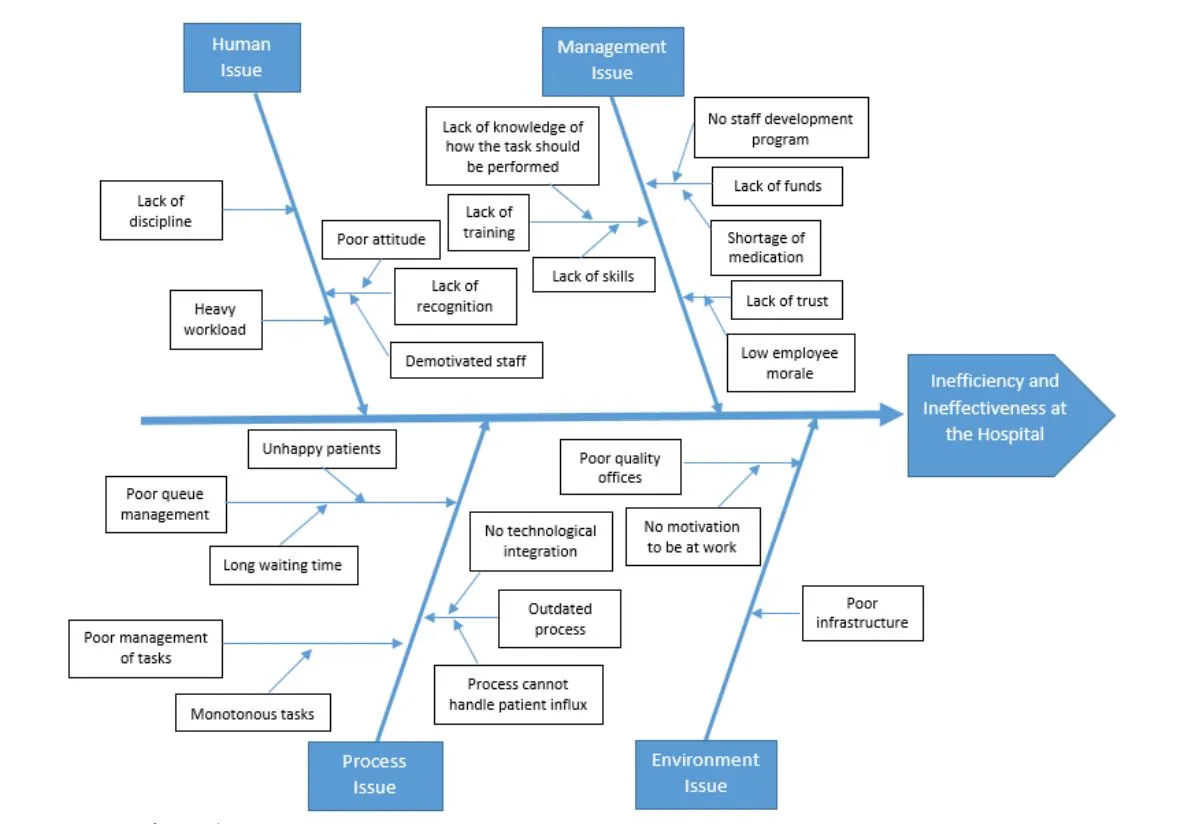
5) Patient Journey Strategy

The patient journey strategy (PJS) is a visual representation strategy of your patient’s experience. It allows you to capture the path that a patient follows when they book an appointment, sign up for a care service membership, or otherwise interact with your medical business.
This strategy focuses on every single touchpoint (places where patients interact with your business) and hone in on what can be improved, fixed, or removed.
Patients are the lifeblood of your business and zero in on your patient’s pain points, challenges, and needs are critical for success.
Some of the benefits of using this strategy are:
- Anticipate multiple patient pathways
- Understand the patient’s perspective
- Inform your staff and employee about what should be improved
- Target patient more closely and increase personalization
- Improve patient experience
- Uncovering easy-to-overlook aspects of your business
Here’s a snapshot of a patient journey of medical practice and how the team identified potential issues and problems

Click here for to
larger version
.
6) Risk Assessment Matrix Framework

The Risk Assessment Matrix creates a framework where you can assess the urgency and the likelihood of any potential threat that might affect your business.
This strategy also allows you to better allocate your efforts across multiple aspects of your business based on the potential severity of any risk. In addition, it’s a great way to visualize and prioritize where and when should you take action against any business threats.
Risks in this framework should be ranked according to low probability and severity (one- colored green) to the highest possible likelihood (ten-colored red). Ranking them in this way lets your team tackle the biggest threats with a sharp action plan.
Here’s an example of this framework:
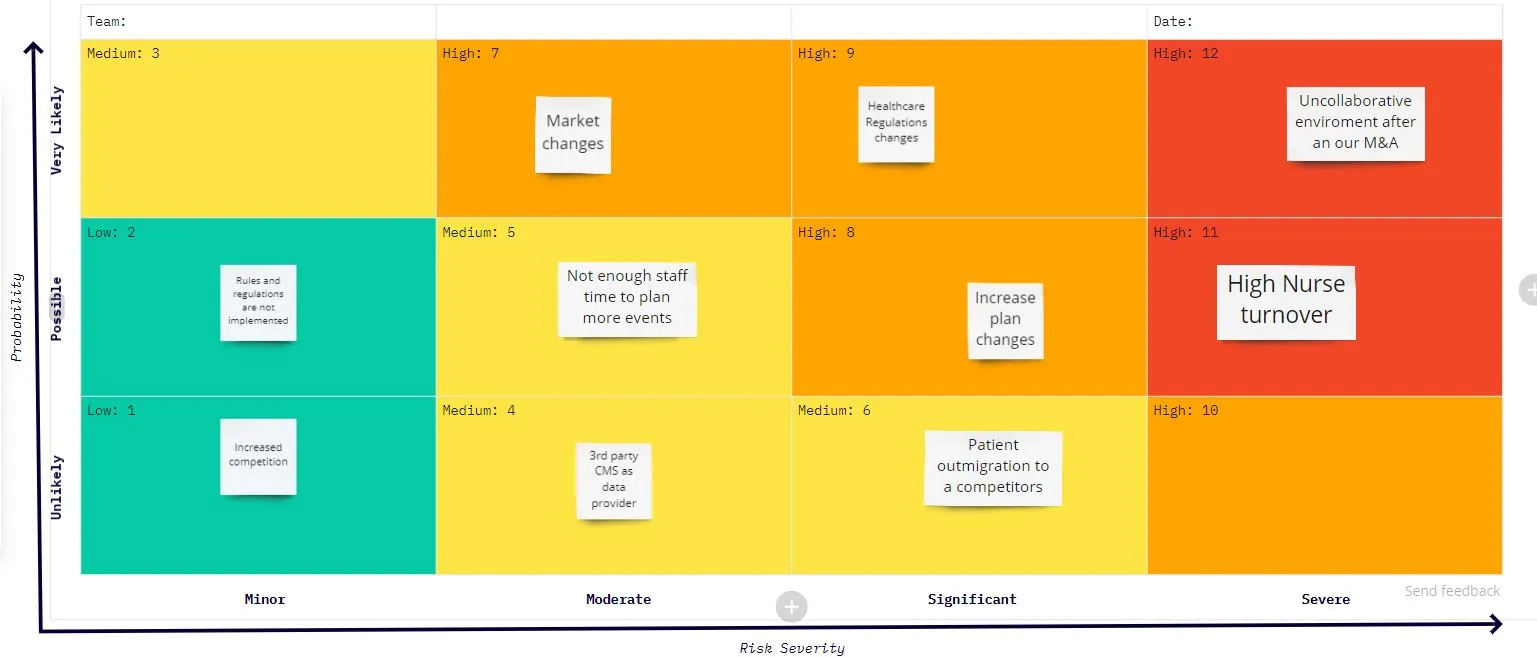
You can access the full version here .
7) OKR (Objectives & Key Results) Framework

OKRs stands for Objectives & Key Results. An OKR framework helps medical businesses solve their critical organizational problems. As a framework, OKRs also help healthcare leadership teams discuss how the work of the staff ties back to the overall business strategy.
OKRs should be transparent to everyone: top-down, bottom-up, and cross-functional. When everyone’s looking at the same framework, everyone has the opportunity to work toward the same outcomes.
Objectives are the vaccine to “blue sky thinking” – their goal is to help articulate what you want to accomplish. An objective is significant, concrete, and drives you to get tasks done.
Key results are the way you’re going to get those tasks done. Specific and measurable, these quantitative goals act as benchmarks for how you’ll reach objectives. (Think outcomes or results in real numbers.)
8) Brand Prioritization Framework
The Brand Prioritization Framework (BPF), or priority matrix, helps your medical teams prioritize initiatives or service lines based on their impact on your medical brand and the level of effort needed for success.
With nine “buckets” or areas of interest, your team can decide if an idea or plan is low, medium, or high effort. The team can also accordingly decide if that plan will likely have low, medium, or high impact.
As a visual framework, the Brand Prioritization Framework helps you promptly reach an agreement on quick wins, big projects, filler tasks, or anything that could waste time.
An example of the BPF for might be:
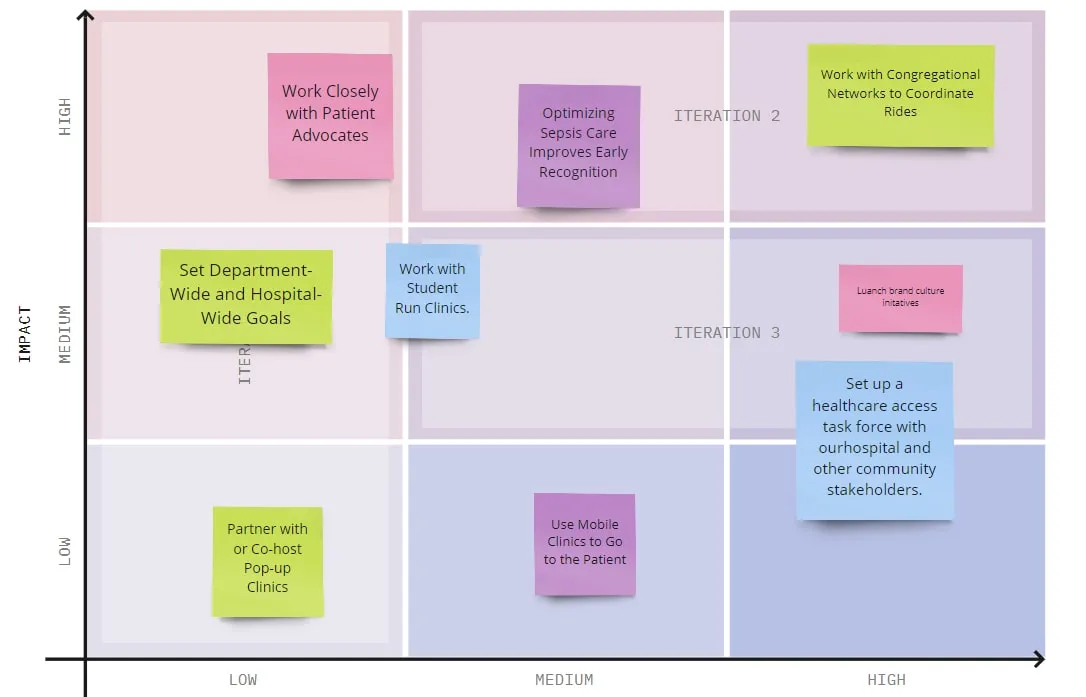
You can access a large resolution here .
The ‘secret’ to a fruitful healthcare strategic plan
A great healthcare strategy is always directed by the brand’s attributes. A strategic plan won’t take any business anywhere if it is not guided by your branding strategy.
A planning strategy could potentially hurt your healthcare brand equity (your perceived worth) if it veers off from your brand’s positioning . If you’d like to learn more about branding in healthcare and how it can overhaul your strategic plan, you can check our guide here .
If you’re busy and looking for great healthcare brand strategy facilitators, contact us here and we’d gladly help you.



